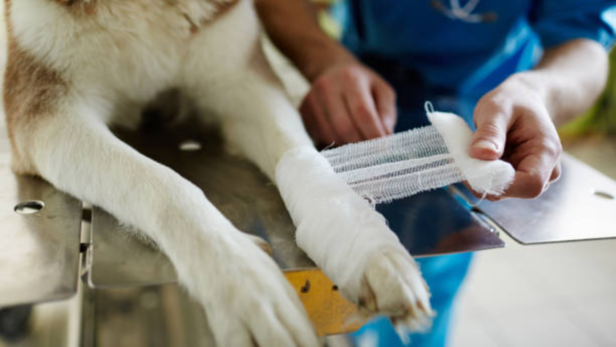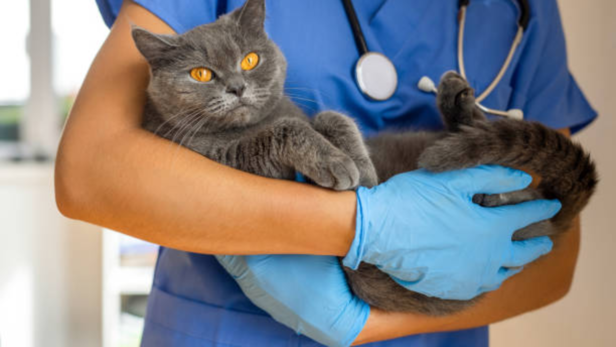Your guide to first aid for pets: Be prepared for any emergency
News Desk | Apr 23, 2025, 09:00 IST

Learn how to handle unexpected situations with our pet first aid guide, packed with essential emergency pet care advice. From minor injuries to serious incidents, this guide offers practical pet first aid tips every owner should know. Be prepared to act quickly and confidently when your furry friend needs you most. A must-read for all pet parents!
Our pets are not just animals but cherished members of our family. Accidents or medical emergencies may occur suddenly with pets, and knowing basic first aid can save the day. Whether it's a minor scrape, choking, or something more serious like a seizure or poisoning, prompt action can be critical until professional help is available. In this article, we’ll walk through the basics of pet first aid, offer practical tips, and explain what to keep in a pet first aid kit.
Pet first aid is the immediate care provided to a sick or injured animal until they can be treated by a veterinarian. It is not a substitute for veterinary care, but it can stabilise the condition and avoid further complications. Being able to react properly in an emergency might just save your pet's life.
Start by keeping calm; your pet will likely be stressed or in pain, and your calm demeanour will help ease their anxiety. Approach them slowly and gently, watching for signs of aggression or fear. Injured pets may bite or scratch, even if they are usually friendly, so use a towel or cloth to carefully restrain them if needed. Make sure you have your vet’s emergency contact saved and locate the nearest 24/7 animal clinic in advance.

Emergencies range from road accidents to allergic reactions, heatstroke, or toxic substance ingestion. In all these situations, time is critical. For example, if your pet is bleeding, use a clean cloth to press on the wound to stop the bleeding. If they are choking, look in their mouth for any visible obstruction and attempt to remove it carefully without pushing it further. When you experience poisoning, don't force your pet to vomit except in the rare cases where a vet instructs you to do so, because vomiting can end up doing more damage than good.
For scalds or burns, wash the affected area with cold water and apply a moist, clean cloth over it before rushing to the vet. In case your pet is suffering from a seizure, keep them safe by clearing objects they could bump against and do not touch their mouth. Comfort them after the seizure has subsided, and reach your vet as fast as possible.

One of the most important things about pet first aid is learning to monitor your pet's vital signs. Knowing what's normal for your pet will let you know if something is amiss. Check their heart rate, breathing, gum colour, and body temperature. The normal heart rate for a dog is 70-120 beats per minute, for a cat it is 160-180 beats per minute. Healthy gums are a bright pink colour and moist; pale or blue gums may suggest shock or lack of oxygen.
It's also good to know how to give a simple pet CPR. If your pet is not breathing and has no pulse, start chest compressions and perform breath resuscitation. For a dog, 100–120 compressions per minute is optimum. The mouth of the pet should be closed, and air given through the nose every 30 compressions. This technique should only be used when necessary and only until veterinary help is available. Always have a list of emergency contacts and information about allergies or medical issues your pet has. If your pet is taking medication, have instructions in your kit for easy access.
Preparation for emergencies is one of the best things you can do as a pet owner. Learning the fundamentals of pet first aid, maintaining a well-stocked first aid kit, and remaining calm in emergencies can prepare you to respond quickly and effectively. First aid is not a replacement for veterinary attention, but it can keep your pet stable until professional treatment can be accessed. Just as you'd protect your family members, treat your pets with the same care they deserve.
Pet first aid guide
Pet first aid is the immediate care provided to a sick or injured animal until they can be treated by a veterinarian. It is not a substitute for veterinary care, but it can stabilise the condition and avoid further complications. Being able to react properly in an emergency might just save your pet's life.
Start by keeping calm; your pet will likely be stressed or in pain, and your calm demeanour will help ease their anxiety. Approach them slowly and gently, watching for signs of aggression or fear. Injured pets may bite or scratch, even if they are usually friendly, so use a towel or cloth to carefully restrain them if needed. Make sure you have your vet’s emergency contact saved and locate the nearest 24/7 animal clinic in advance.

Emergency first aid can save your pet's life
Emergency pet care
Emergencies range from road accidents to allergic reactions, heatstroke, or toxic substance ingestion. In all these situations, time is critical. For example, if your pet is bleeding, use a clean cloth to press on the wound to stop the bleeding. If they are choking, look in their mouth for any visible obstruction and attempt to remove it carefully without pushing it further. When you experience poisoning, don't force your pet to vomit except in the rare cases where a vet instructs you to do so, because vomiting can end up doing more damage than good.
For scalds or burns, wash the affected area with cold water and apply a moist, clean cloth over it before rushing to the vet. In case your pet is suffering from a seizure, keep them safe by clearing objects they could bump against and do not touch their mouth. Comfort them after the seizure has subsided, and reach your vet as fast as possible.

Normal heart rate for a cat is 160-180 beats per minute
Pet first aid tips
One of the most important things about pet first aid is learning to monitor your pet's vital signs. Knowing what's normal for your pet will let you know if something is amiss. Check their heart rate, breathing, gum colour, and body temperature. The normal heart rate for a dog is 70-120 beats per minute, for a cat it is 160-180 beats per minute. Healthy gums are a bright pink colour and moist; pale or blue gums may suggest shock or lack of oxygen.
It's also good to know how to give a simple pet CPR. If your pet is not breathing and has no pulse, start chest compressions and perform breath resuscitation. For a dog, 100–120 compressions per minute is optimum. The mouth of the pet should be closed, and air given through the nose every 30 compressions. This technique should only be used when necessary and only until veterinary help is available. Always have a list of emergency contacts and information about allergies or medical issues your pet has. If your pet is taking medication, have instructions in your kit for easy access.
Preparation for emergencies is one of the best things you can do as a pet owner. Learning the fundamentals of pet first aid, maintaining a well-stocked first aid kit, and remaining calm in emergencies can prepare you to respond quickly and effectively. First aid is not a replacement for veterinary attention, but it can keep your pet stable until professional treatment can be accessed. Just as you'd protect your family members, treat your pets with the same care they deserve.
- What are the ABCs of animal first aid?
The ABCs of pet first aid are Airway, Breathing, and Circulation. First, clear the airway by looking for obstructions in the throat and mouth. Second, check that the animal is breathing, look for movement of the chest or listen for airflow. Third, check for circulation by feeling a heartbeat or pulse. These steps are the building blocks for checking and treating an emergency. - What is the
first aid for pets ?
Pet first aid includes immediate steps that are taken to stabilise your pet in case of injury or sickness. These include controlling bleeding, CPR, burn treatment, the removal of foreign bodies from choking, and keeping them safe and calm until a veterinarian can attend to them. It also entails checking vital signs and employing a pet first aid kit where necessary. - What should be in a pet first aid kit?
Your pet first aid kit must contain all the essentials, such as gauze, bandages, adhesive tape, antiseptic wipes, tweezers, scissors, digital thermometer, latex gloves, muzzle or soft cloth to restrain, saline solution for flushing wounds, and any medications that your pet may be required to take. In addition, it will be convenient to include your pet's medical records, emergency contact information for vets, and a simple pet first aid guide. Place it in a waterproof container and have it reachable at home and on the road.
Discover expert advice and the latest tips onpet care , training, health, and more. Stay updated with all things pets at Times Pets!
